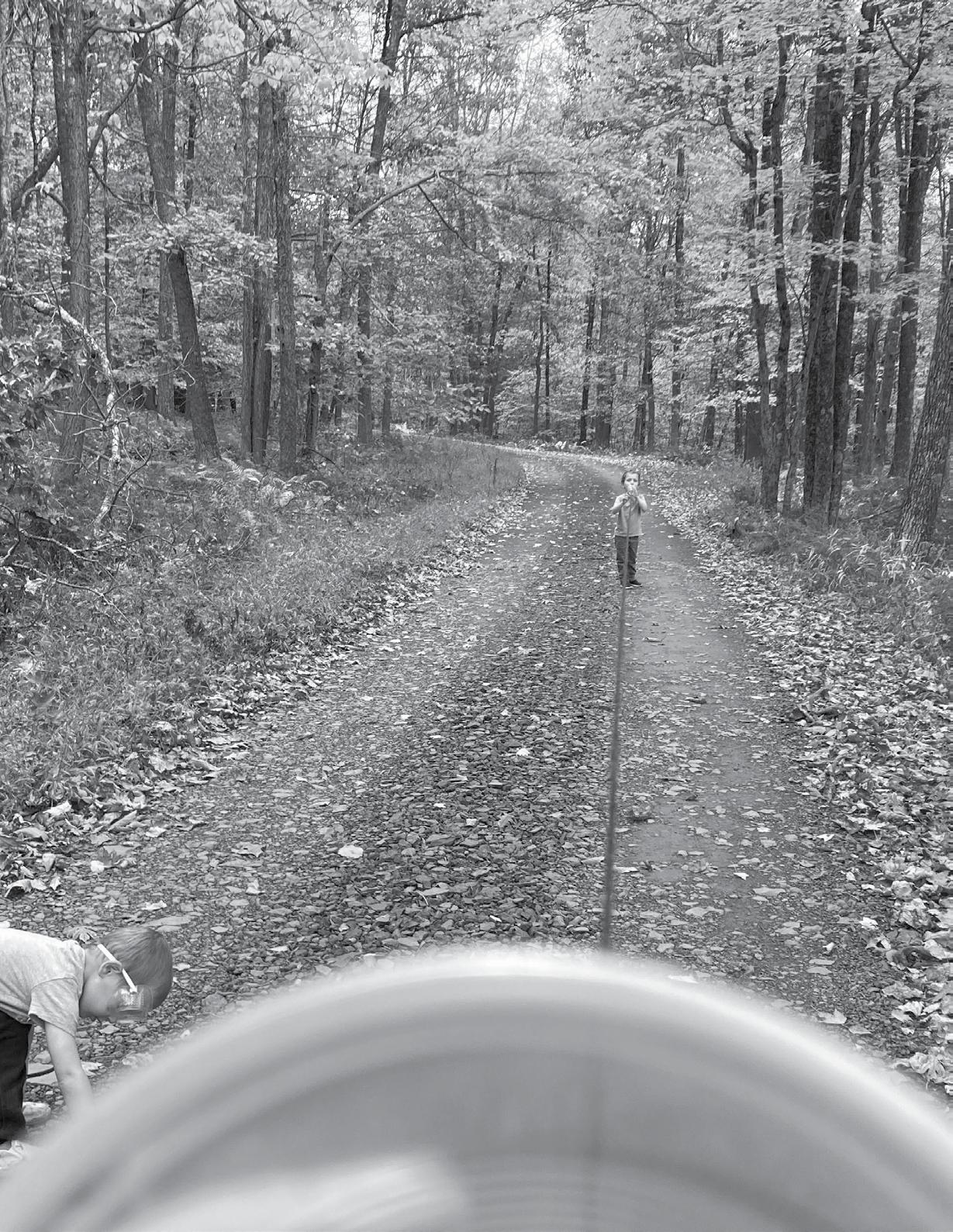

INFRASTRUCTURES FOR CONNECTION
ABSTRACT
Our desire to communicate beyond the range of the human voice is one of the largest drivers of technology throughout our history. From smoke signals to the optical telegraph, humans have trained themselves and their environment in the service of connection. Today, our tools of communication are quite different. While smart phones allow us to be everywhere and anywhere at any given time, they limit the mediums through which we can communicate. What we have lost is the power from which the instruments of our communication affect how we communicate. In the past, they had a voice as much as the message, defining what we perceived and how we perceived it. Now the infrastructure that makes up our current mediums of communication is hidden, removed from our everyday understanding. Space satellites and buried cables make our communication seem magical. The various costs of this infrastructure is similarly buried within complex billing contracts and government subsidies.
In Infrastructures for Connection, I ask what the social, environmental, and political benefits are to reinvigorating our ancient and vestigial means of connection within the built environment. With a review of ancient tools of communication, I show how these mediums change what can and can’t be said, and the pros and cons of their use. Then, looking to the future and focusing on New York City, I revive a classic cultural medium, carrier pigeons, which could connect garden communities in all five Burroughs, and increase the use of and benefits from NYC’s many disparate gardens. For example, pigeon feathers make great down, their droppings a more sustainable fertilizer, their meat a valuable food source.
Alongside these benefits, I propose the installation of an ancient European means of connection, the Semaphore, as an integral part of the Hudson River revitalization program by the Hudson River Park Trust. As a means of connecting the parks and piers on the Westside of Manhattan, they increase tourism, propagate education, and create a means of play for visitors and residents to New York’s Hudson River. Central to these initiatives is an emphasis on the idiosyncratic means of communication that they offer: to see the power behind what we can say by the difference in the tools we use.
4 RESEARCH FELLOWSHIP 2021
INFRASTRUCTURES FOR CONNECTION

WITH NO VARIETY IN VEHICLES OF THOUGHT, OUR CAPACITY TO THINK DIFFERENTLY BECOMES LIMITED.
INTRODUCTION
The desire to communicate over a distance farther than the human voice was one of the biggest drivers of technology throughout our history, leading us to overcome what seemed like the insurmountable obstacles of time and space.
The media used to accomplish communication have taken a myriad of forms, each eliciting different cognitive abilities and emotional responses from both the sender and the receiver. From smoke signals to Twitter, instruments and their range define what we perceive and how we perceive it. Each medium is a vehicle for thought, offering distinct affordances for creative expression and understanding.
Whistled languages, for example, commonly used to communicate across deep gorges or dense forests, were co-opted for their anonymity by Hmong lovers in China. Since it is harder to identify someone through their whistling than through spoken word, couples could whistle intricate niceties to each other while hiding in plain sight. For the Berbers, it was the immediacy and long-range benefit of whistling that led to it’s usage as a resistance tool of communication against the French.
Today, we conduct most of our communications through a few devices: cell phones, tablets, computers, etc. Whether to profess love, talk business, share knowledge, or raise concern, we have homogenized what would otherwise be idiosyncratic exchanges. The “always-on and always on you” (Turkle, 2008) pervasiveness of these digital devices has also distorted our sense of time and space. We arrive at places that are worlds apart through the same screen. We are seen here, read there, and heard elsewhere without having to move. Range is not physical but perceptual when our technological intermediaries bring elements remote in space into our proximate sphere.
When communication can be asynchronous, when our medium lives with us, we can be anywhere, anytime.
But before this untethered landscape of smart phones in our pockets and wide use Internet, long-range communication explicitly depended on our physical surroundings to work. We experimented with burning different organic materials to get good visible smoke and leveraged the homing capacity of pigeons to deliver important messages. The vestiges of some of these infrastructures still stand in many regions of the world--relics of the first attempts to breach range. Semaphore towers can be seen scattered throughout Europe, the beacon towers along the Great Wall of China have been standing for millennia, and whistled languages still bounce off mountain ranges.
These explicit physical infrastructures, whether built or appropriated, manifested communication by making it feel tangible, alive, and mechanical. They also required explicit engagement and undivided attention from us. Today, the screen’s limited format reduces our incredible sensory-motor abilities, our boundless imaginative skills, and knack for meaning-making. It also makes us oblivious of the infrastructures that it relies on—the Internet and its data, its satellites, server farms, and cooling systems. Ubiquitous computing is everywhere and nowhere to be seen, making it hard to understand or manipulate the infrastructures that facilitate our lives. We have abstracted their concreteness down to the vocabulary—we use the word “Cloud” to refer to millions of impactful data centers— obscuring the systems and processes that facilitate our exchanges. This physicality has important material, environmental, social, and political implications which, when out of sight, remain out of mind. The changing formats have also created an increasingly divisive landscape where some groups have been systematically excluded (Marvin & Graham, 2001).

EVERY NEW MEDIUM IS A MACHINE FOR THE PRODUCTION OF GHOSTS.”
—JOHN DURHAM PETERS, SPEAKING TO THE AIR

WHAT ARE INFRASTRUCTURES OF COMMUNICATION?
Larkin (2013) defines infrastructure as built networks that facilitate the flow of goods, people, or ideas and allow for their exchange over space. “Peculiar to infrastructure is the fact that it is a thing as much as it is the relationship between things—as much brick and mortar (or cables and tubes) as the information or matter they move around.”
Anthropologist Susan Lee Star (1999) has offered a series of characteristics that apply to all that is defined as infrastructure, regardless of the form of their provisions.
According to Star, infrastructures:
• Offer spatial and temporal reach, connecting you to other times and places.
• Require you to learn how to use them.
• Are linked to conventions of practice and have cultures and norms about their use.
• Are built in modular increments.
• Are embedded and forgotten once there.
• Are transparent; they work best when noticed least.
In her Challenging Infrastructures book, Daphne Dragona (2018) poses the following question:
“How much agency do we have when we hardly understand the infrastructures that connectivity depends upon?
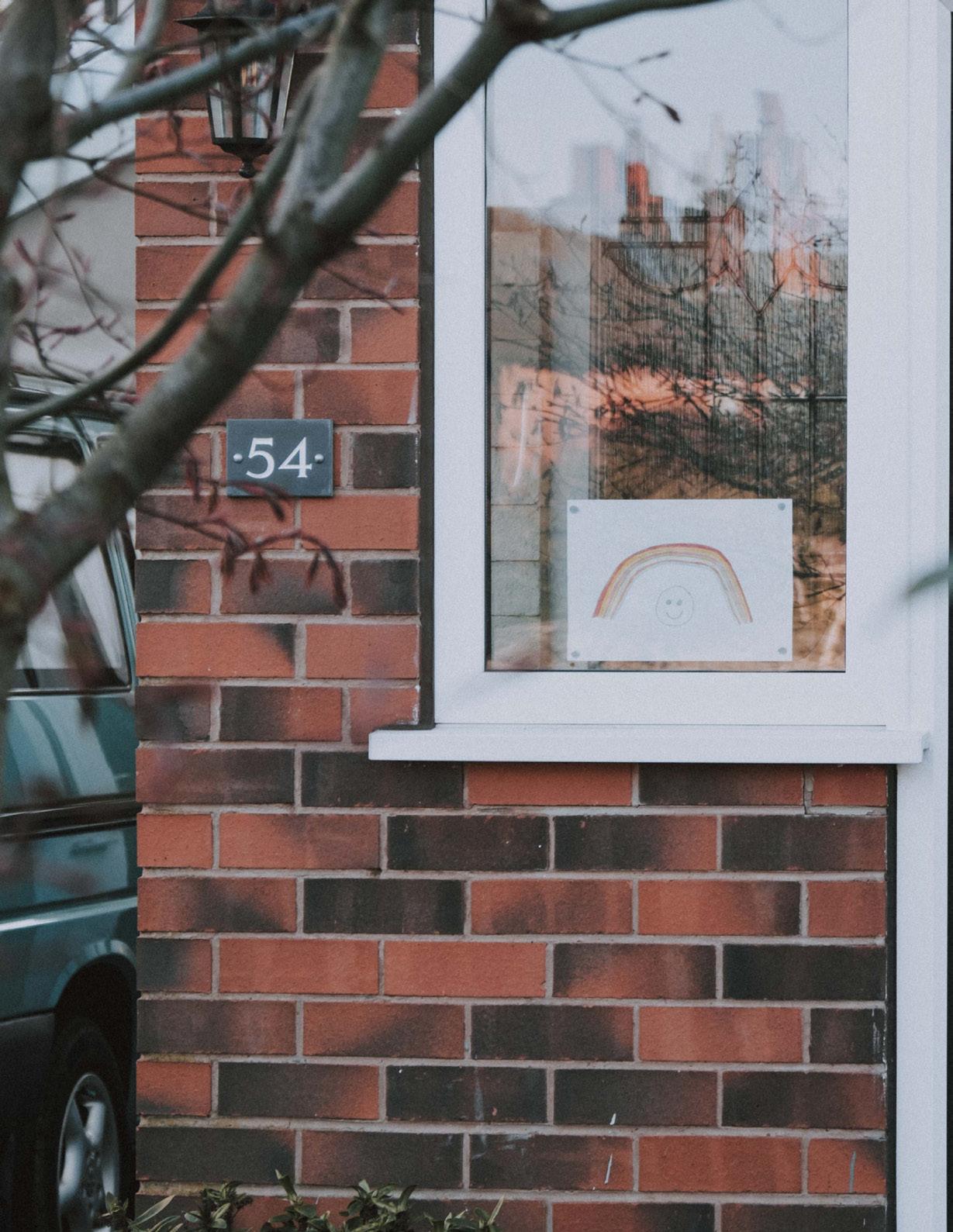
HOW CAN WE REMAIN SOCIALLY AND EMOTIONALLY CONNECTED WHILE PHYSICALLY APART?

CONNECTING IN CONFINEMENT
The morning of November 7th, the sudden eruption of applause, pot-banging, cheering, and honking could be heard in cities across the country. For many, this was the first sign that the nail-biting 2020 election season had come to a conclusive end.
Confinement forced us to look out from our windows, to sit on our stoops and fire escapes, to turn our rooftops into dance floors and our balconies into stages. From there, we joined in the 7 o’clock cheer for front-line workers and were audience to impromptu concerts. While outside, we walked by rainbows, tapped on windows, and looked up at messages spelled on skyscraper’s selectively lit windows. We were reaching out by whatever means possible.
These acts of expression, agency, and participation are varied, inclusive, and inventive. They are spontaneous, contagious, and organic. It is important to note that this expressions happen between objects, spaces, and people.
They illustrate our need to connect socially and emotionally. They beautifully showcase our resourcefulness at finding expressive ways to convey kinship from far away yet so close.
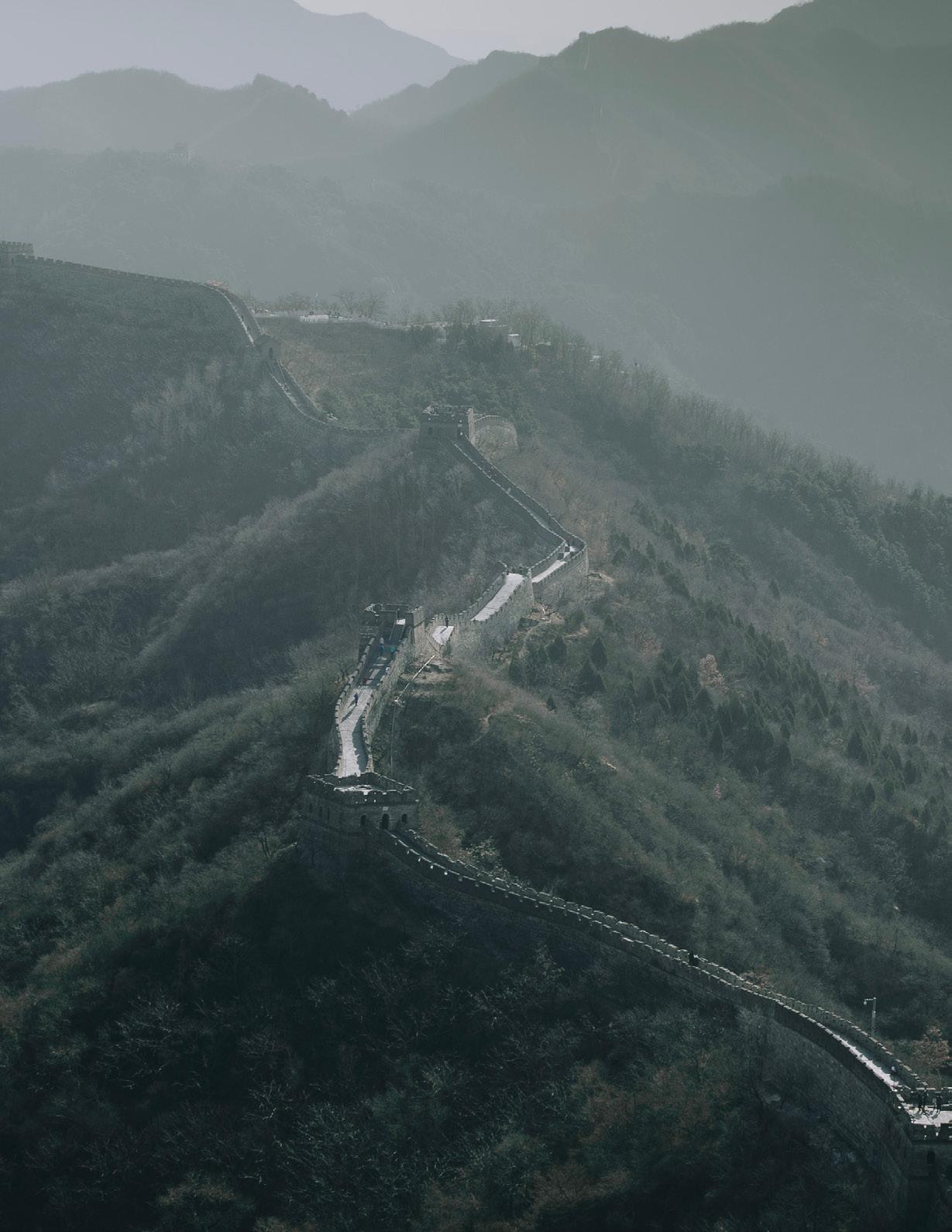
HUMAN BEHAVIOR IS REGULATED BY THE HIDDEN DIMENSION OF SPACE AND THE SILENT LANGUAGE OF TIME.”
—E. HALL

PRE-ELECTRIC TELECOMMUNICATION SYSTEMS
Envisioning infrastructures for long-distance communication that tap into a variety of vehicles of thought required us to look at the pre-electric telecommunication systems of our past. These function by leveraging both the affordances provided by the environment along with those granted by our senses. They beautifully display how resourcefulness and acute awareness of the surroundings has been exercised in order to connect at a distance.
Contextualized and idiosyncratic, these systems make use of different means and media. Some work with sight, some through sound. Some require the sender and receiver to master a skill, like drumming or whistling, or the common knowledge of a coded signal to be deciphered.
Synchronous or asynchronous, their infrastructures are explicit and intricately dependent on environmental conditions. They depend on clear skies to be seen, on people to relay information, or on the homing capacity of feathered friends to deliver the message — the only example in which transmitting information is not decoupled from the need of sending material media, but unique in that it relies on an interdependent relationship with a living being.
The proposals that follow this small selection of preelectric telecommunication devices do not aim to change our current reality but to suggest new models with their own scale and purpose.

From the Olympics to Genghis Khan to Normandy’s invasion during World War II, homing pigeons have been used to reliably deliver news, messages, and small packages. Even with invention of the radio and the telegraph, homing pigeons were still preferred when delivering sensitive information (Blechman, 2006).
Eastern India used homing pigeons up until 2002 to provide emergency communication services following natural disasters.
ORIGIN
DATE
MEDIUM
In 2009, a South African IT company pitted an 11-month-old bird carrying a 4 GB memory stick against the ADSL service (Asymmetrical digital subscriber line) from its biggest Internet service provider, Telkom. The pigeon, Winston, took an hour and eight minutes to carry the data 80 km (50 miles)— the same amount of time it took to transfer 4% of the data over the ADSL (Govender, 2009).
Late Egypt, Huns, Romans, Greeks
3000 BC in Egypt - oldest account
Magnetoreception (a sense which allows an organism to detect a magnetic field to perceive direction, altitude or location). Variety of domestic pigeons (Columba livia domestica) derived from the wild rock dove, selectively bred for its ability to find its way home over extremely long distances.
INFRASTRUCTURE
Dovecote, pigeonnier USE
Postal carriage, wartime communication pigeons can carry up to 75gr of weight.
DATA TRANSFER/RANGE
DIRECTIONALITY
RELATIONSHIP
TECHNIQUE
93/mph - maximum adult male speed. Longest recorded flight: 7,200 miles in 24 days, from Arras, France, to Saigon, Vietnam in 1931.
Back and Forth.
One to one, one to many, many to many
Pigeons are thought to navigate by sensing the earth’s magnetic field and by using the sun for direction. Pigeons carried messages only one way, to their home and had to be transported manually before another flight. However, by placing their food at one location and their home at another location, pigeons have been trained to fly back and forth up to twice a day reliably, covering round-trip flights up to 160 km.

Smoke signals, the oldest form of communication at a distance, broadcast predefined information about a singular occurrence. Used worldwide and across a significant time period, smoke signals require both sender and receiver to have a common understanding of what is being transmitted.
An optical medium, smoke signals use variations in color, shape, and frequency of the smoke to convey information and the latitude at which the fire originates (Kerkhove 2015).
ORIGIN
DATE
MEDIUM
INFRASTRUCTURE
USE
DATA TRANSFER/RANGE
DIRECTIONALITY
DISTANCE/TIME
RELATIONSHIP
TECHNIQUE
ADVANTAGES
DISADVANTAGES
Stories on the use of smoke signals are found far in time. The Odyssey tells of Agamemnon’s erecting a 500-km line of beacons and using beams to transmit the news of Troy’s fall in 1084 BC. The Persian King Darius I (550–485 BC) had a fire-telegraph network throughout Persia. In Ancient China, soldiers stationed along the Great Wall sent messages as far as 750km in just a few hours (Telecom History).
Independently in different parts of the world
Oldest account is from ancient China (1250 BC)
Smoke from burning damp grass, reeds, saltpeter, sulfur, wolf dung, and other organic matter
Conical earth-mounds upon commanding points, such as the tops of hills, elevated river-points or towers.
Transmit news, signal danger, gather people
Visibility depends of line of sight, but signals can be relayed. A human eye can see a lit candle as far as 2.75 km away.
Back and forth
Relayed messages across the Great Wall took less than a couple of hours to travel 750 km.
One to one, one to many, many to one, many to many
Different fuels were used to produce different kinds of smoke. Damp leaves and dung for example, would be used to produce dark smoke, while wood and some dried grasses produce a white smoke. To produce different puffs or streams of smoke, a wet blanket or hide would be placed over the fire and then removed, tubes made of bark were used as well to direct smoke.
Broad stroke communication, limited complexity
Visible to anyone in range, needed encoding

Talking drums have been used since time immemorial to communicate across distance. They work by imitating the rhythm, tone, and pitch of tonal languages, achieved by varying the drum skin’s tension.
Messages sent by talking drums require more words than a written message since the message needs to be contextualized. Single words become phrases; for example, “moon” would be played as “the Moon looks towards earth” (Finnen, 2004).
ORIGIN
In some ethnic groups, people have “drum names,” this way, messages could be specifically addressed. The sender would send the receiver’s name, followed by her own and then the message (Kendall, 2019).
West Africa most prominently, but East Africa as well. Melanesia and South East Asia, Papua New Guinea and tropical America
DATE Antiquity
MEDIUM
USE
DATA TRANSFER/RANGE
DIRECTIONALITY
RELATIONSHIP
TECHNIQUE
Two drumheads connected by leather tension cords by which the pitch can be regulated to mimic the tone and prosody of human speech (talking drums).
All-wood instruments hollowed out from a single log and hit with sticks, beating out rhythms of high and low notes (slit gongs)
Alerting neighboring villages of possible attacks or to announce ceremonies, yet not confined to utilitarian messages - poetry, storytelling, proverbs and praise messages were also sent this way
Up to 32 km, where others would relay if necessary. It would take about 8x longer to convey the same message drumming than speaking, but it can reach much further, given you can hear a person yelling up to 2-3 km away.
Back and forth
One to one, one to many, many to one, many to many
Using low tones (male) and higher tones (female) the drummer communicates through the phrases and pauses. Each short word is accompanied by an extra phrase which would be redundant in speech but provided context to the core drum signal.

Whistled languages originated in remote, mountainous villages or dense forests, where environmental conditions required a method of communication that could travel over long distances. Whistles don’t echo as much as shouts, which means they’re less likely to get distorted or scare away potential prey, and thanks to the high-frequency pitch of the sound, they can travel many times further than shouts. Plus, they require less exertion on the part of the speaker (Robinson, 2017).
Whistled languages are based on spoken language,and as such, they are not distinct.
Nonetheless, they are used on different occasions. Whistling allows whistlers to transmit and comprehend anything over long distances by emulating the tones and vowels, prosody, and intonation of a spoken language. There are over 70 identified whistled languages around the globe, and it is speculated that whistling might have been the stepping stone towards spoken language (Meyer, 2016).
ORIGIN
DATE
MEDIUM
USES
DATA TRANSFER/RANGE
DIRECTIONALITY
RELATIONSHIP
TECHNIQUE
There are over 70 identified groups across the world who use whistling to express themselves with all the flexibility of normal speech. One of the first accounts of a possible whistled language comes from Herodotus, describing the speech of Ethiopians as bats squeaking in the 5th century BC.
Antiquity
Forced breath through a small hole between one’s lips or teeth
Regular communication, alerting and confounding, religion, courtship and poetry
Up to 8 km in open conditions
Back and forth
One to one, one to many
The hands and fingers play a key role in getting the pitch and length of each whistle right. Whistles rely on one of two strategies, both of which use changes in pitch to create a stripped-down skeleton of the spoken language. In tonal languages, the whistles follow the melodies that are inherent in any spoken sentence. In languages that are not naturally tonal, the whistles mimic the changes in resonance that come with different vowel sounds, while the consonants can be discerned by how abruptly the whistles jump and slide from note to note.
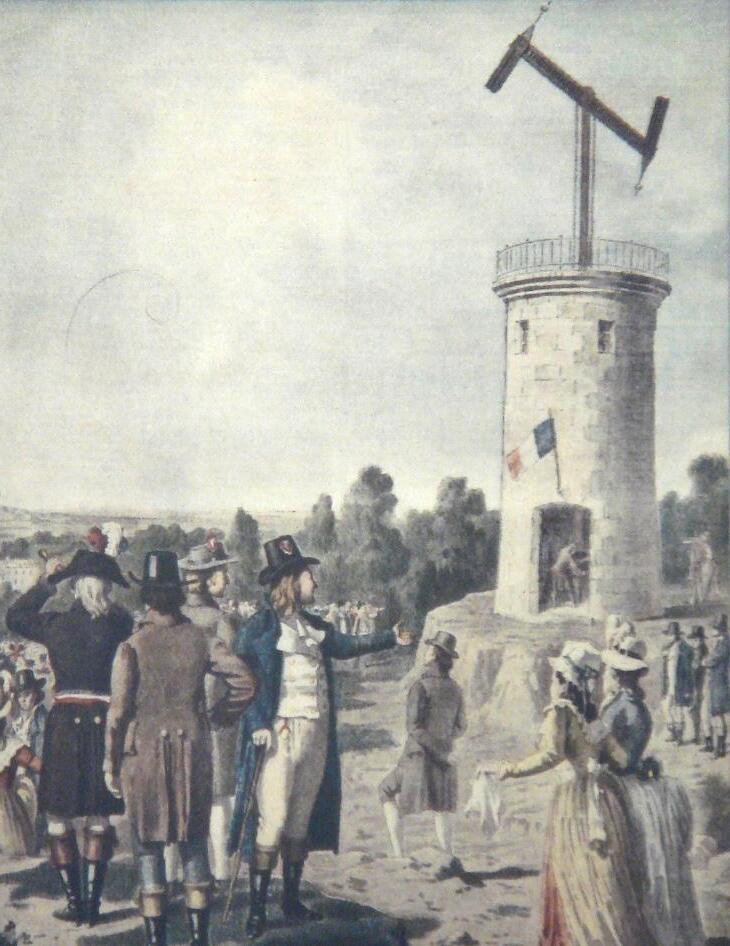
OPTICAL TELEGRAPH (LE SYSTEM CHAPPE)
The semaphore was the first successful, large-scale communication network that allowed transmission of messages faster than horse-riding. Invented in France by Claude Chappe, it quickly becomes the largest network using optical telegraphy.
At its peak, the semaphore network had 556 stations covering over 3,000 miles (Schoeffield, 2013).
The system required a series of towers placed no more than 20 miles apart. Each tower had an apparatus with two movable wooden arms connected by a crossbar.
By moving these, the operator could make a total of 196 different symbols observed by the next tower’s operator with a telescope, relaying the message from tower to tower.
The system was adopted throughout Europe and was in use for more than 50 years before being replaced by the electric telegraph, with the last semaphore going out of service in Sweden in 1880 (Patowary 2017). ORIGIN France, quickly spreading throughout Europe, particularly Sweden and the UK
TECHNIQUE
Operators on towers would relay messages from tower to tower by moving the arms of the semaphore, creating encrypted symbols which would be seen through a telescope.

COMMUNICATION WITH DIVERSITY AND DIFFERENCE
This research will look at the pre-digital infrastructures of the past which, grounded in material form, are explicit in their use: leveraging their environment to function.
As physical constructs, these infrastructures are also architectures of association. Their semiotic and aesthetic qualities are no less important than their purely technical functioning: they strengthen our experience of the real, of cultural and social interaction.
At a time in which technology is designed to become more natural and habitual, and infrastructures more abstract, we decompress an incredible amount of information with a pretty limited subset of our motor and sensory abilities. This research aims to imagine what an infrastructure for long-distance communication that allows for multiplicity and difference would look like.
For this task, I have taken a decisively constructivist approach, that is, the idea that people actively contribute to the construction of their knowledge by shaping their world through action and mediating their world through symbol use.
In the words of E. Ackermann (2001):
“To a constructivist, knowledge is not a commodity to be transmitted—delivered at one end, encoded, retained, and re-applied at the other— but an experience to be actively built, both individually and collectively.”
Our fi rst scenario imagines creating a network of community gardens in New York’s fi ve boroughs through messaging pigeons; the second ponders what exchanges could emerge if we break the Hudson River Park’s linearity by connecting its piers through optical telegraphs.
These ideas predate Covid, yet it would impossible to not take a cue from the impact the pandemic has had on our definition of connection. Covid has made it clear that while it may not be possible to live without the digital day-to-day, our need for physicality, materiality, and serendipity is undeniable. It has also been made clear that at a time in which we are over dependent on the media to connect us to the rest of the world, one of the greatest challenges is to foster the distinction between the representation of things and the physical reality of things.
Place still matters, and is as important as ever. The idea that once time becomes spontaneous, space becomes unnecessary, is far from true. It is because of the incredible growth of digital technologies that space and matter are just as important.
New York City is sometimes called the media capital of the world. While on a day-today basis communications flows out from the city, over the past decades several disasters have affected intercity communications. Among 9/11’s most heartbreaking revelations was that the police, firefighters and medical personnel couldn’t talk to each other by radio, leading to mass confusion and scores of unnecessary deaths. During Hurricane Sandy, a lack of power led to a lack of cell phone access. Situating the following scenarios in New York City serve to temporarily delights tourists as well as connect the residents spread across five boroughs and multiple neighborhood cultures.

WE’RE SO USED TO THE PACE OF PROGRESS IN COMPUTING THAT THESE INCREASES IN STORAGE DENSITY ARE ONLY MILDLY NOTEWORTHY . . . WHAT’S MORE INTERESTING (AND PROBABLY MORE CONSEQUENTIAL) IS HOW OUT OF PROPORTION OUR ABILITY TO BOTH GENERATE AND STORE DATA IS GROWING RELATIVE TO OUR ABILITY TO MOVE IT AROUND OVER THE KINDS OF NETWORKS THAT ARE ACCESSIBLE TO MOST PEOPLE.”
—EVAN ACKERMANCOMMUNITY GARDENS AND MESSAGING PIGEONS
In New York City, where backyards are rare, community gardens serve beyond growing vegetables and flowers. They are spaces where people work collectively for shared benefit. Whether it is yearning for contact with nature, the need for a creative outlet, a longing for beauty, or wanting a sense of community, gardens provide contact with something real, alive, and ephemeral. Gardening makes us use our bodies in ways that matter and give us the added benefit of delivering enormous gratification through tangible results. It is no wonder that people turn to gardening in times of distress and isolation!
Beyond the personal benefits that gardening supplies, community gardens reclaim public space and facilitate social and cultural expressions, becoming effective platforms for shared knowledge.
New York City has over 550 community gardens spread across its five boroughs. Most of these service their immediate community and require membership to gain access. While alliances are fostering an active network of community gardens, the everyday exchanges remain local.
New York also has a long history with pigeon keeping. Introduced by immigrants mostly of Italian, Polish, and Irish descent, by the 1940s and 1950s creating a
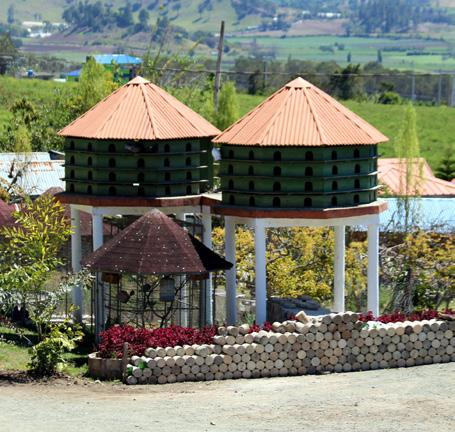
vast web of pigeon fanciers across the five boroughs (Jerolmack 2013).
Today, real-estate development and population shifts have caused the practice to dwindle with most of it is segregated to parts of Brooklyn and Queens. Nonetheless, the tradition of pigeon keeping remains alive, if only in its confines.
Interactions with animals animate society and the experience of the place they cohabitate. It impacts how we think about community, identity, and the built environment. Yet urbanism typically forgets to include non-humans, even though society as we know it has been dramatically shaped by the interaction between wild and civilized creatures. These have been constituting one another beyond feeding and domestication. The horse, for instance, drastically altered and shaped the world we know now through its speed and power.
While there was an up-tick in dog parks, rooftop beehives, and chicken coops in the last decade, pigeons have suffered a different fate. Uncanny and ubiquitous, pigeons split people between fans and foes, despite being the oldest domesticated bird, offering a wide range of benefits to their keepers for millennia.
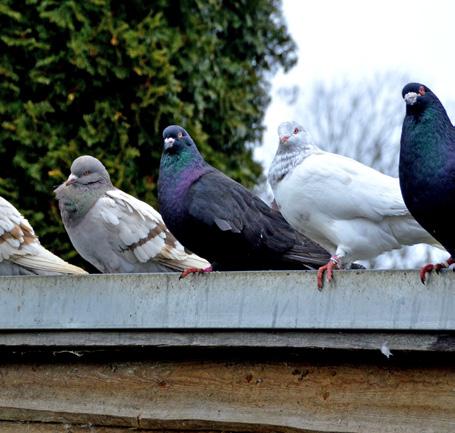 Dovecotes in the Dominican Republic
Dovecotes in the Dominican Republic
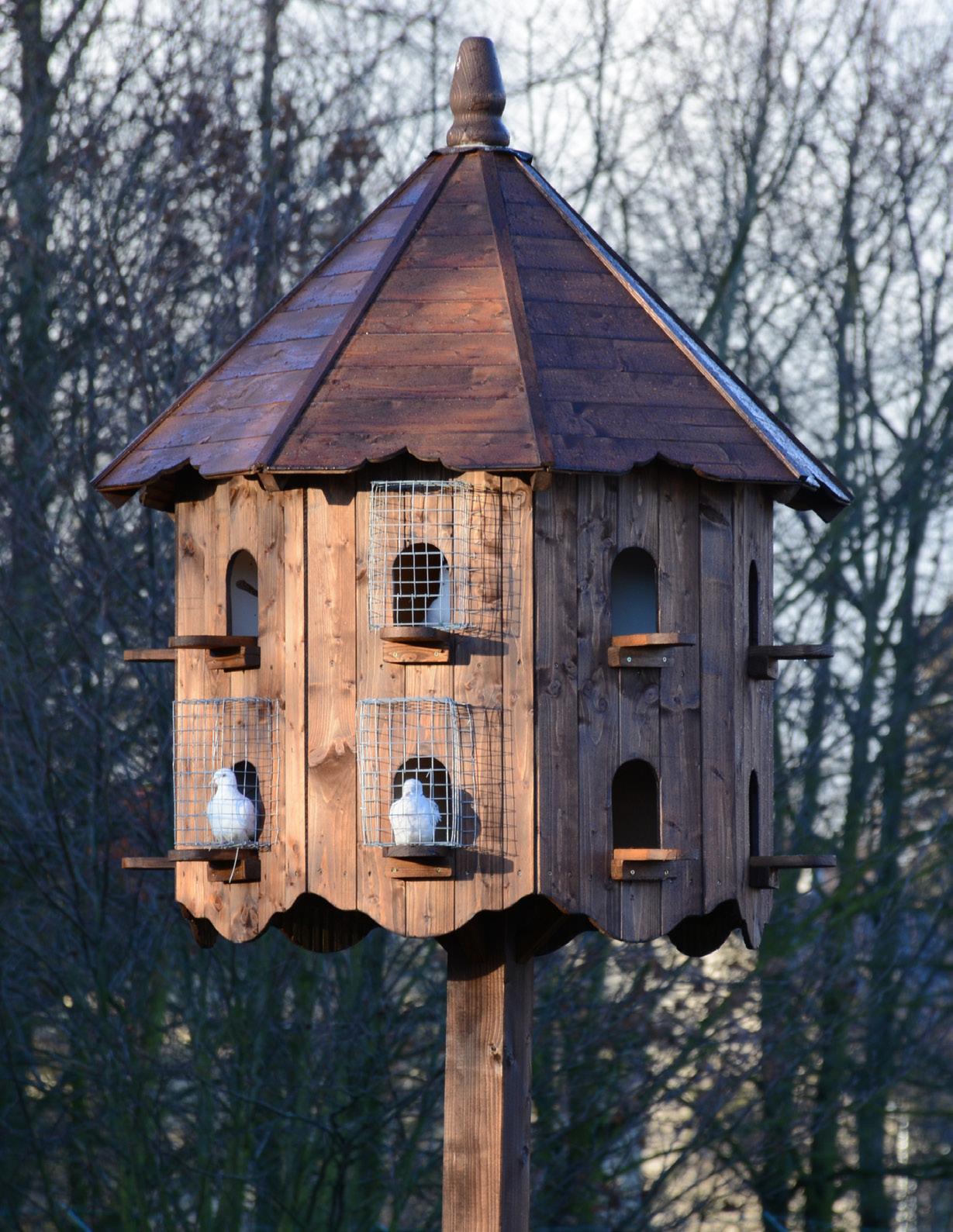
DOVECOTES CAN BE UNIQUELY DESIGNED TO REFLECT THE GARDEN THEY BELONG TO.
Pigeons, apart from their ability to send messages, are a reliable source of meat and eggs. They can be fed on a range of farming byproducts and minimally processed crops, and the byproducts of their butchering can be provided to omnivores. They need relatively low maintenance and are cleaner than other fowls Unlike chickens, they will bathe daily if given water to do so. Pigeons will calibrate their breeding with available food, but if desired, they can multiply quickly.
Pigeons can be taught to fly back and forth. Dualhomed pigeons keep their nest in one location and water and feed in another. This eliminates the need for moving the birds physically between gardens.
Once treated, pigeon feathers can be used for down and pillows. Their manure, when composted down, is an unsurpassed fertilizer for high feeder plants. Rich in saltpeter, it has been used as an oxidizing agent to help remove tree stumps.
Could we leverage pigeons’ homing ability and other keeping perks by placing dovecotes in community gardens? Can we create a network of community gardens by connecting them through homing pigeons?
Imagine this: New Yorkers in the five boroughs can send handwritten messages, seeds, and cuttings to each other from one community garden to another by way of a carrier pigeon.
At record-breaking speed (93mph), the message or little package (30-50 grams) will take around 15 min to be delivered 23 miles away, from the Bronx to Staten Island. A more moderate 15 mile trip at the speed of an
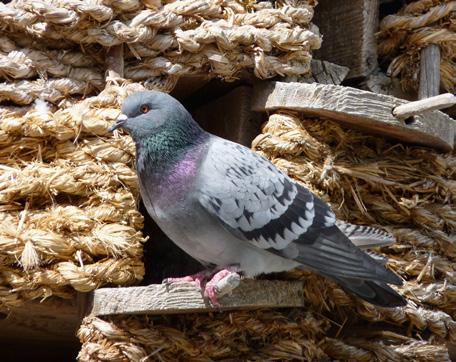
average pigeon would take around the same time, so in an hour, you might have sent and received a message.
At a local level, exchanges of all sorts are sparked by introducing these feathered friends into community gardens. Interacting with pigeons animates the garden; their keeping adds a novel offering and attracts new members who might otherwise not have joined. The byproducts of pigeon keeping, such as manure, feather, and eggs, support the garden’s sustainability and serve as a resource in times of need.
The pigeons take shelter in a dovecote designed by a garden’s member. While it conforms to function, it is distinctive in its design, with no two community garden dovecotes alike. It lends identity to the garden and sparks curiosity to visit others.
Children and elders share in the amusement brought about watching pigeons’ behavior, and everyone shares in the excitement of receiving a note from a distant fellow, of seeing it arrive by air, delivered by a pigeon who’s being cared for.
The note is handwritten, and the paper has traces of soil. It also contains some seeds along with instructions on how to tend to them. There is even a little drawing of what the bud will look like in due time!
Swaps happen between gardens and between people, each message a surprise to the receiver who feels compelled to reply back in kind. Observations and best practices are interchanged, and a network of shared knowledge is slowly laid out.
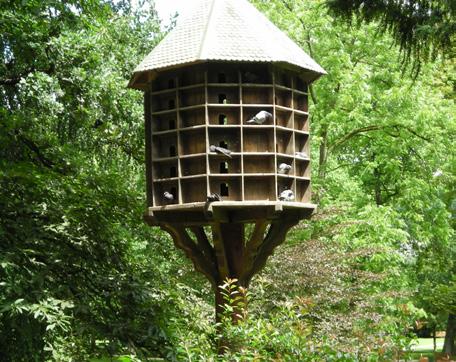 Pigeon in a dovecote
Pigeon in a dovecote


INFRASTRUCTURES FOR CONNECTION
Interactions with animals animate society and the experience of the place they cohabitate. It affects how we think about community, identity, and the built environment. New York City has over 550 community gardens. Most of these service their immediate community and require membership to gain access. While alliances are fostering an active network of community gardens, the everyday exchanges remain local. By selecting a community garden in each borough, we can see the surprising speed with which a carrier pigeon may take a message, a group of seeds, etc. throughout Manhattan. In the route on the left, carrier pigeons could travel to all five Burroughs in less than an hour, connecting all of the 550 disparate gardens. Combined with the clear efficiency of this form of communication comes the environmental, retail, and social benefits mentioned above.

Taking a community garden in each borough, and calculating the time it would take for a message to arrive if flown at maximum speed as an example:
• The Bed-Stuy to the Upper East Side: 7 miles / 5 min
• The Upper East Side to Queens: 13 miles / 8.5 min
• The Bronx to Queens: 19 miles / 13 min
• The Staten Island to the Bronx: 23 miles / 15min

Chappe-system for optical conveyance of messages using special semaphore towers.
OPTICAL SEMAPHORES + THE HUDSON RIVER
New York City is shaped by the waters surrounding it, and the Hudson River has been crucial in making the city into what it is today. Lenape natives fished in its waters until the early 18th century, and passenger ships and cargo-bearing vessels made it one of the world’s busiest ports. Over the years, larger ships and cargo planes accelerated the pier’s decline, and by the end of the 20th century, most of the docks had been abandoned.
In the late 1990s, the Hudson River Park Trust was created, making its mission to revitalize what was once a deteriorated waterfront and turning it into a vibrant riverfront linear park that stretches along 4 miles of Manhattan’s west side, from Tribeca to Hell’s Kitchen. The park has successfully reconnected New Yorkers and visitors with the historic Hudson River by restoring over a dozen piers and transforming them into vibrant spaces for recreation (Hudson River Park Trust).
Linear parks offer great advantage in increasing park access. The perimeter to area ratio means more people are likely to live near the park and therefore enjoy it. You can go to the Hudson River Park from almost any latitude on the West part of Manhattan you are at.
Nonetheless, linear typology has its caveats. What they offer in contiguity can lack in cross-connectivity. Usually retrofitted to waterfronts, disused railroads and the like, their spacial geometry is a result of adaptation. Linear parks, therefore, have to design lateral porosity and find ways to embrace linearity as an asset.
One way to do this would be by adding a layer of connectivity along the park that allows its visitors to engage locally as well as longitudinally.
A crucial advantage of the Hudson River Park is the piers that dot its length. Raised above the water by pillars and jutting out from the shore, piers offer a clear line of sight from one to the next. This feature makes them great candidates for the placement of
optical systems for long-distance communication. Placing a semaphore system on its piers would allow visitors to engage with each other regardless of not being co-located in the same latitude.
Telegraphy is the long-distance transmission of textual messages by way of a semaphore system.
A semaphore uses an apparatus to create a visual signal which is transmitted over a long distance. Unlike messaging pigeons, where an object holding the message is exchanged, a semaphore sends the message. Thus, a semaphore can make use of a wide variety of mediums as long as they can be made visible or cause an effect on the recipient’s end. Smoke, sunlight, flags, and hydraulics, for example, have been used for this purpose.
The piers along the Hudson River are spaced out at an average of half a mile. Given that someone with a healthy vision can see a candle flame from about 1.6 miles away (assuming a clear line of sight with no fog or other obstructions), large structures placed at one-mile intervals could be easily read, with each one relaying the information to the next.
Consider the game of telephone. People pass along information to each other through 1-on-1 whispers. The result usually evolves into something unrecognizable compared to the original message. In this case, the creation and interpretation of the message could be a communal activity, instigating a playful series of misinterpreted appropriations. These constructed representations imbue our own existence in them and reveal more profound truths than efficient communication allows.
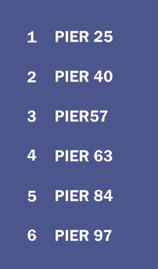
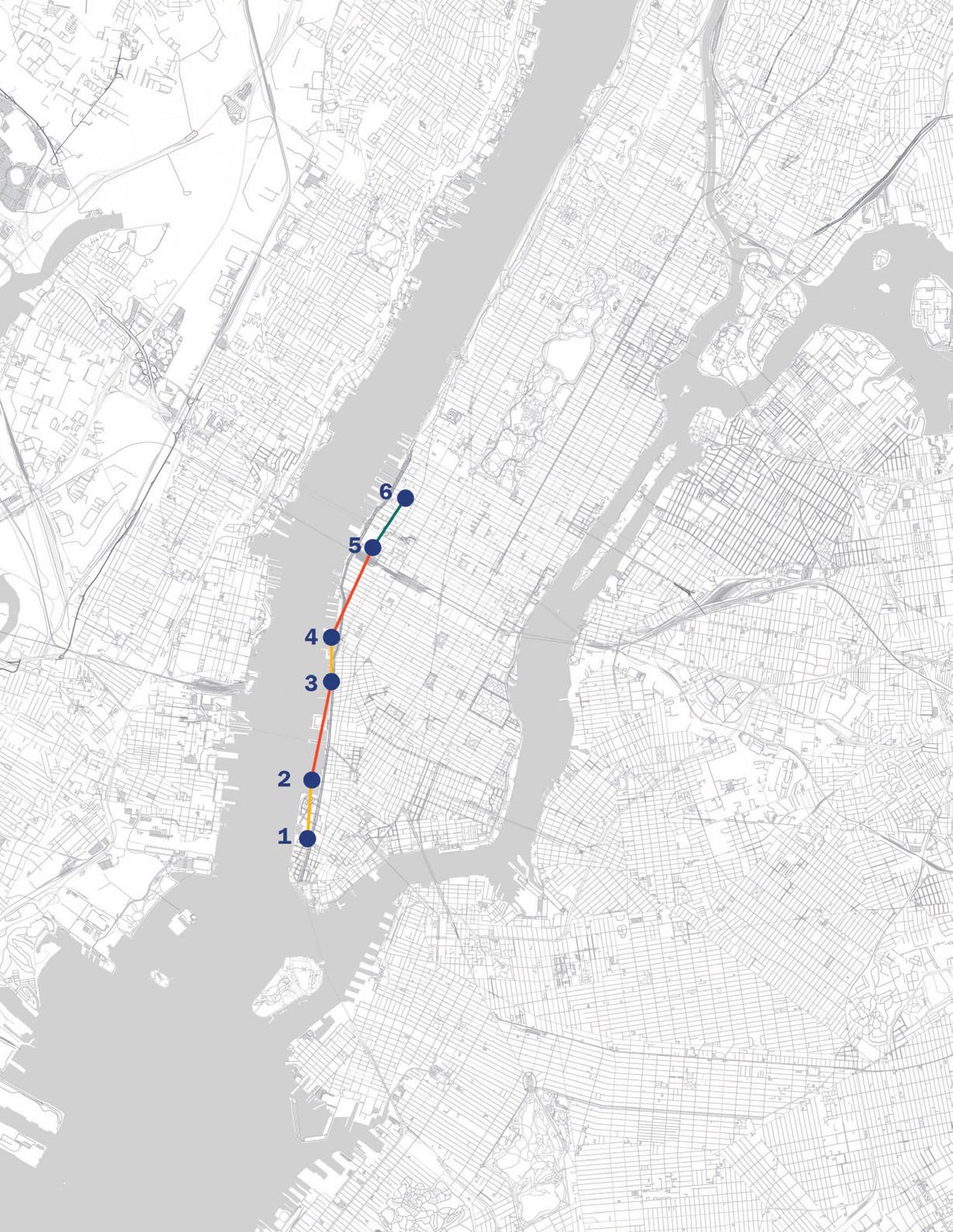
SIX SEMAPHORES COULD COVER THE PARK’S EXTENT, PLACED AT NO MORE THAN ONE MILE FOR EASY VISIBILITY WITHOUT THE NEED OF A TELESCOPE.


OPTICAL SEMAPHORES
A semaphore uses an apparatus to create a visual signal that transmits over a long distance. Consider the game of telephone. People pass along information to each other through 1-on-1 whispers. The result usually evolves into something unrecognizable compared to the original message. In this case, the creation and interpretation of the message could be a communal activity, instigating a playful series of misinterpreted appropriations. They attract tourists with their use, educate NYC’s children with their history, and add to the Hudson River Park Trust’s foundational promise to revitalize the Westside waterfront for all.
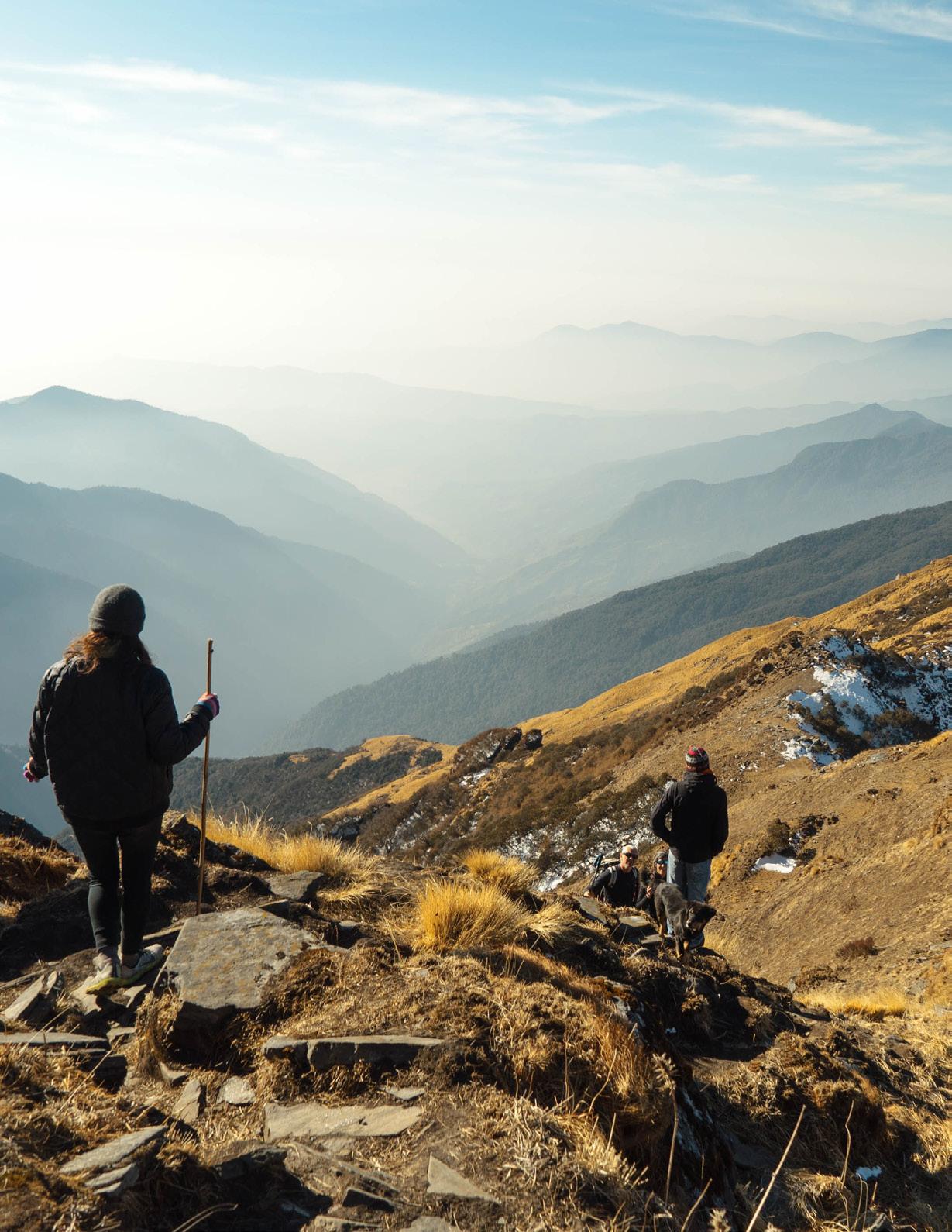

CONCLUSION
Humans have a fundamental need for contact with other humans. Our interactions and relationships with other people form a network that supports us, makes our lives meaningful, and ultimately enables us to survive.
The infinite bandwidth and processing-rich computing environments that now extend to our architectural surroundings and personal, carried interfaces have dictated how we consume the world and the quality of the exchanges we have with one another.
The reduction of this exchanges and the concealment of the infrastructure have made us less aware of our surroundings, and limited the richness of our experience to that which can be perceived through a screen.
This research looks at the past as a source in order to imagine a future where digital information does not stand in the way between us and our surroundings, but connects us to our surroundings more deeply.
If the artifacts we create are the springboards of further creative thought, I hope that these emerge from the acknowledgment of an internal state and an external stance, and that the tools to create them tacitly celebrate the many paths to knowledge acquisition.
REFERENCES
1. Ackermann, E. (2001). Piaget’s Constructivism, Papert’s Constructionism: What’s the difference?
2. Blechman, A. D. (2006). Pigeons : The fascinating saga of the world’s most revered and reviled bird. Grove Press.
3. Dragona, C. (2018). Challenging Infrastructures: Alternative Networking & the Role of Art, Aksioma Institute for Contemporary Art.
4. Finnen, W. C. (2004). Talking drums : reading and writing with African and African American folklore, fact, and fiction. Portsmouth, NH, Teacher Ideas Press
5. Govender, P. (2009). Pigeon transfers data faster than South Africa’s Telkom. R. O. News, Reuters Online News.
6. Graham, S. and Simon M. (2001). Splintering Urbanism. Routledge.
7. Hall, E. T. (1992). The hidden dimension. Peter Smith Pub.
8. Jerolmack, C. (2014). Global Pigeon. University of Chicago Press.
9. Kendall, B. (2019). “The talking drums of West Africa” BBC News.
10. Kerkhove (2016). Aboriginal Smoke Signaling and Signaling Hills During Resistance Warfare.
11. Larkin, B. (2013). The Politics and Poetics of Infrastructure. Annual Review of Anthropology
12. Meyer, J. (2016). Whistled Languages. Springer-Verlag Berlin An.
13. Patowary. K. (2017). The World’s First Telegraph Amusing Planet
14. Peters, J.D.(1999). Speaking into the Air a History of the Idea of Communication. University of Chicago Press.
15. Robinson, D. (2017). “The beautiful languages of the people who talk like birds.” The Human Planet.
16. Schoefield, H. (2013) “How Napoleon’s Semaphore Telegraph Changed the World.” BBC News
17. Star, S.L. (1999). The Ethnography of Infrastructure. American Behavioral Scientist.
18. Turkle, S.(2008). Always-On/Always-On-You: The Tethered Self. Handbook of Mobile Communication Studies.
19. Graham, S. and Simon M. (2001). Splintering Urbanism. Routledge.
CREDITS
Primary Author: Edwina Portocarrero, 2020 Health and Design Fellow
Secondary Authors: Jessica Charlap, Rebecca Milne, Mark Muster
Contributors: Lizabeth Kerkhoff, Wendy Soto
Advisory Panel: Betsey Olenick Dougherty, Scott Fallick, Jeff King, Nasra Nimaga, Rebecca Milne, Judy Ou, Mark Muster Photography Copyright: Cover Image by Edwina Portocarrero Page 4 Photo by Cottonbro | Pexels
Page 6 Photo by Patrick Untersee | Unsplash
Page 8 Photo by Adobe Stock
Page 10-11 Photo by Marc-Olivier Jodoin | Unsplash
Page 12 Photo by Mali Maeder | Pexels Page 14 Photo by Siim Lukka | Unsplash
AUSTIN
BOSTON
CHARLOTTE
CHICAGO
COSTA MESA
DALLAS
DUBAI
GUAYAQUIL
LOS ANGELES
MUMBAI
NEW YORK
OAKLAND
PITTSBURGH
RALEIGH
SAN FRANCISCO
SHANGHAI
STAMFORD
TORONTO
WASHINGTON DC
WWW.PERKINSEASTMAN.COM
